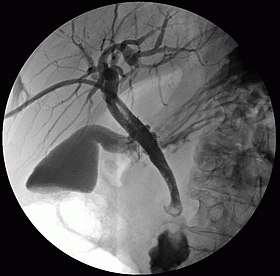Cholangiography
Cholangiography is the imaging of the bile duct (also known as the biliary tree) by x-rays and an injection of contrast medium.
| Cholangiography | |
|---|---|
 Percutaneous transhepatic cholangiography | |
| ICD-9-CM | 87.5 |
| MeSH | D002758 |
| OPS-301 code | 3-13c |
Types
There are at least four types of cholangiography:
- Percutaneous transhepatic cholangiography (PTC): Examination of liver and bile ducts by x-rays. This is accomplished by the insertion of a thin needle into the liver carrying a contrast medium to help to see blockage in liver and bile ducts.
- Endoscopic retrograde cholangiopancreatography (ERCP). Although this is a form of imaging, it is both diagnostic and therapeutic, and is often classified with surgeries rather than with imaging.
- Primary cholangiography (or perioperative): Done in the operation room during a biliary drainage intervention.
- Secondary cholangiography: Done after a biliary drainage intervention.
In both cases fluorescent fluids are used to create contrasts that make the diagnosis possible. Cholangiography has largely replaced the previously used method of intravenous cholangiography (IVC).
Magnetic resonance cholangiopancreatography (MRCP) is another cholangiography method.
gollark: Idea: name an esolang something which is unrepresentable as a wiki page title, Discord message or spoken out loud.
gollark: Zstd 1.1.3 contains a multi-threaded compression API that allows a compression operation to leverage multiple threads. The output from this API is compatible with the Zstandard frame format and doesn't require any special handling on the decompression side. In other words, a compressor can switch to the multi-threaded API and decompressors won't care.
gollark: ???
gollark: Maybe make it `rand % 16` or something so it'll only have an effect rarely, for extra confusion.
gollark: And yet its type system is a thin layer on top of the JS one.
References
This article is issued from Wikipedia. The text is licensed under Creative Commons - Attribution - Sharealike. Additional terms may apply for the media files.